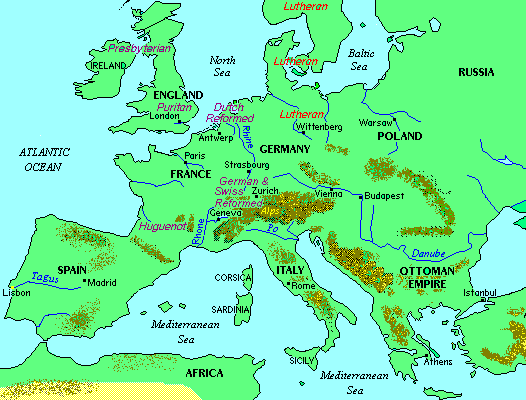
Why was
the Protestant Reformation such a "political" event--and not just a matter
of renewing and strengthening the people's personal faith in God?
-
 Certainly
for Martin Luther that was all he was trying to achieve. He wanted
simply to purify the Christian's personal faith: to bring it back
to the power and glory it had for people in the first few centuries of
its existence after Christ--before it had become caught up in the politics
of the Roman Empire. He wanted to bring Christianity back to its
"roots." He just wanted the church to get rid of the extra "stuff"
(worship of Mary, veneration of the saints, the church as the dispenser
of salvation, indulgences, etc.) that had come into the church over later
centuries and had "corrupted" the original Christian faith. Certainly
for Martin Luther that was all he was trying to achieve. He wanted
simply to purify the Christian's personal faith: to bring it back
to the power and glory it had for people in the first few centuries of
its existence after Christ--before it had become caught up in the politics
of the Roman Empire. He wanted to bring Christianity back to its
"roots." He just wanted the church to get rid of the extra "stuff"
(worship of Mary, veneration of the saints, the church as the dispenser
of salvation, indulgences, etc.) that had come into the church over later
centuries and had "corrupted" the original Christian faith. -
Luther did not
want to get caught up in politics. But there was no way of avoiding
it.
-
When the peasants
called for a purifying of Christian government as well as the church, Luther
came down forcefully against them, a very political act that cost 6,000
peasants their lives.
-
Luther accepted
the protection of the princes of Northern Germany, even though he certainly
had to know that the reason they were coming to his aid had more to do
with building up their own independent power against the Catholic Emperor
and Pope than it had to do with personal spiritual renewal.
-
In fact Luther,
in taking a firm hand over his religious reform movement, made very important
political decisions, the most important of which was to not merely leave
the feudal political system alone--but to surround it with religious support
so that it would stand firm against certain cultural changes that were
taking place elsewhere in Europe. Thus he helped keep Germany under
an ongoing feudal order that lasted well into the 19th century--and under
an attitude toward politics in which the German was trained to leave politics
to the God-appointed political rulers, to not question their authority,
but to follow loyally as a sign of loyalty to God (even such monsters as
Hitler)--an attitude that lasted well into the 20th century. This
was a very political thing to do!
-
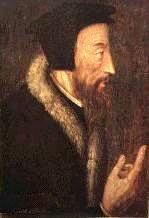 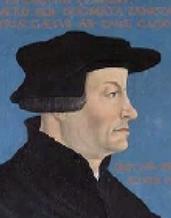 Ulrich Zwingli
and John Calvin understood that to reform the church was to reform all of society
as well. The fact that Zwingli was supported by the city government
of Zurich (Switzerland) and Calvin by the city government of Geneva (also
Switzerland) also had a very strong impact on the shape that Christian
reform took under their leadership. Ulrich Zwingli
and John Calvin understood that to reform the church was to reform all of society
as well. The fact that Zwingli was supported by the city government
of Zurich (Switzerland) and Calvin by the city government of Geneva (also
Switzerland) also had a very strong impact on the shape that Christian
reform took under their leadership. -
The cities were--just
like the dukes, barons and princes of the feudal countryside--very jealous
of their own power and independence. Their city governments (councils
made up of representatives of the wealthy merchants in the towns) liked
the fact that the Swiss Reform movement of Zwingli and Calvin looked favorably
upon their form of government -- comparing the rule of city "fathers" with
the group of "elders" (presbyters) who in the very early church ruled each
of the local congregations. Thus Zwingli and Calvin could give very
important Christian moral support for city governments that wanted to be
free from the feudal lords and barons who claimed to have feudal rights
over the towns. Zwingli and Calvin said "no," to the feudal lords
and barons; they did not have any such God-given "rights" to rule.
-
To Zwingli and
Calvin, the communities of the true Christian faithfuls had the right to
be ruled by elders or presbyters arising from the ranks of the townsmen
themselves, townsmen of proven God-fearing, upright and charitable natures.
These ruling elders came to their position not because of the privilege
of their birth (in the feudal system a person was born into ruling families
and came to power as part of their family inheritance), nor because they
were appointed from "on high" by kings or bishops (the "episcopalian" system).
They came to positions of rule because the people themselves, in electing
these leaders to high office, confirmed the special "call" of God on these
elders with their votes of approval.
-
Thus in the Reform
movement of Zwingli and Calvin, "representative" or "democratic" government
was an integral part of the reform of Christian society.
-
Knox in Scotland
found himself in a very unique position--for while he stood strongly in
favor of Zwingli and Calvin's form of "representative" or "democratic"
government, the political reality was that he was heavily dependent on
the Scottish feudal barons for support of his reform movement.
-
What basically
happened in Scotland was that the church was given the right to elect its
own elders and other church officers. But their power extended no
further than strictly "church" matters.
-
In Scotland that
proved not to be very far. The barons took for themselves most of
the wealth that the church once possessed and left Knox's Presbyterian
church with very little except the tithes of the common folks to support
the work of the church in Scotland. The Scottish church became the
poorest of the churches in Europe as a result.
Was the Protestant
Reformation limited just to Germany, Switzerland and Scotland?
-
No, not at all.
In fact it looked at one point as if all of Europe might become caught
up in the reformation movement. It spread to the Netherlands, England,
France, Poland, Bohemia (land of the modern Czechs), Italy and Spain.
-
But again,
politics--not
personal piety--determined the outcome of the spread of the Protestant
Reformation.
-
In the
Netherlands
the Reformed movement of Zwingli and Calvin was greeted enthusiastically
by the Dutch burghers or townsmen who found Calvin's teachings on Christian
society and politics very much to their own liking.
-
The coastal towns
of the Netherlands (Amsterdam, Den Haag, Rotterdam, Dordrecht, Antwerp,
and others) had become very wealthy under the leadership of important Dutch
merchant families--whose ships traded in goods reaching eventually as far
away as India, the Spice Islands in Southeast Asia and even Japan.
These Dutch traders even held commercial outposts in South America, the
Caribbean and North America (New Amsterdam and the Hudson valley).
-
These Dutch burghers
were a very well educated and energetic class of people, independent-minded
and ready for self-rule, independent of the Habsburg monarchy (the feudal
family ruling Spain, Austria, Burgundy, parts of Italy as well as the Netherlands)
which claimed rights to rule over the Dutch.
-
Calvinist Protestantism
offered the Dutch burghers the moral excuse to overthrow Spanish Habsburg
rule in the Netherlands. Thus the Dutch Reformed Church grew up quickly
in the Netherlands.
-
In France,
especially in southern France, townsmen (bourgeoisie) also were
strongly attracted to the teachings of Calvin. By the mid 1500s,
these "Huguenots" were growing rapidly despite increasing persecution
from French Catholic authorities.
-
The struggle between
Huguenot Protestants and traditional Catholics was made even more complicated
by the struggle for control of the French monarchy between the Guise and
Bourbon families: the Guises were fiercely Catholic (as we saw in Scotland
under the French regent, Mary of Guise) and the Bourbons sympathetic to
the Huguenots.
-
Also many of the
French feudal families were attracted to Protestantism--for the same reasons
as the Scottish noblemen in Scotland and the German noblemen in Germany.
It offered them the moral opportunity to get out from under the grip of
the kings and queens who still ruled over them.
-
French regent
Catherine de Medicis tried very hard to bring religious peace to France
by recognizing the rights of Huguenots in certain towns and regions (mostly
southern and western France) in with her Edict of Toleration in 1562.
But the Catholic party of Guises were bent on violence--including the slaughter
of Huguenots at Vassy that same year, and wars provoked against the Protestants
that went on and off for the next years. But the Huguenots held on
against the persecution of the Guises.
-
Protestantism,
especially of Calvin's Reformed variety, spread also to East and Southern
Europe where it found support among the rising urban middle classes.
But persecution by kings and emperors in these regions was more forceful
and unceasing--causing Protestantism to grow very slowly.
How did Protestantism
come to England?
-
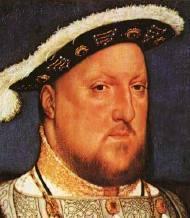 In
England Protestantism had come early into the country in half-way measures
through Henry VIII (8th) who in the early 1530s began to pull away
from Roman Catholicism because of the need to find a wife would would deliver
him a male heir to his throne. He divorced one wife after another
in that quest. In
England Protestantism had come early into the country in half-way measures
through Henry VIII (8th) who in the early 1530s began to pull away
from Roman Catholicism because of the need to find a wife would would deliver
him a male heir to his throne. He divorced one wife after another
in that quest. -
This displeased
the Pope, not only because the Church was opposed to divorce, but because
his first divorce was to Catherine of Aragon, aunt of the powerful Catholic
Spanish King and Holy Roman Emperor, Charles V.
-
The break in the
relations with Rome over this issue led Henry to get the English clergy
and nobility in 1532 to agree to name King Henry as "defender of the faith"
and "head of the church in England." The Pope would no longer have
any influence in England. Not all agreed--and those that failed to
agree were quickly put to death, including the very influential humanist,
Sir Thomas More.
-
Then with the
support of Parliament (the English national legislature) in 1534 Henry
moved to seize all moneys that used to be sent out of England as payment
to Rome (which was a very large amount).
-
Helping Henry
grow more bold in his grab of the church was Thomas Cromwell, his principal
secretary, one with well-known Protestant sympathies. Cromwell advised
Henry to strengthen the king's treasury by closing down all corrupt monasteries
in England and seizing their wealth (1536). By 1540 Henry had succeeded
in closing almost all the country's monasteries and sending thousands
of monks and nuns into poverty.
-
In turn he sold
most of these lands to wealthy Englishmen, the "new men," who would from
then on stand in terror of the thought of the Catholic church ever being
restored to power in England. The fear of having to give their new
lands back to the church made staunch Protestants of the whole group.
-
Cromwell and the
arch-bishop of Canterbury, Thomas Cranmer, however were interested in more
than politics. The religious teachings of the Protestant movement
interested them greatly--and they encouraged Protestantism in theology
as well as politics in England.
-
Henry followed
their lead somewhat--but remained really interested in only one subject:
his own power.
-
For Henry, the
problem of a male heir still remained. Once again he moved through
a series of marriages and divorces, which even caught up Cromwell as a
victim of a marriage mismatch.
-
Things after Henry
died in 1547 got terribly confused as Catholics and Protestants maneuvered
against each other to control the powerful national monarchy.
Edward
VI was only 9 when he took over from his father--and in no position
to control all the court intrigue. By and large the pro-Protestant
party held control (this was the group responsible for Knox's release from
slavery and his coming to England to preach). But Edward was a sickly
boy and died of tuberculosis six years later.
-
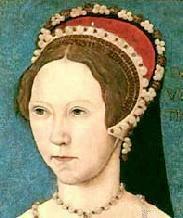 His
place was taken by his half-sister, the very Catholic Mary Tudor,
daughter of Catherine of Aragon. Now the Catholics were in power. His
place was taken by his half-sister, the very Catholic Mary Tudor,
daughter of Catherine of Aragon. Now the Catholics were in power. -
Mary was inclined
to be cautious. But her marriage to the future Philip II of Spain,
fiercely Catholic, pointed to growing problems for the Protestants in England.
But this marriage was also a very unpopular event in England--for it threatened
to make England merely a Spanish province and it threatened to put the
English under the same cruel Spanish hand that was causing such misery
in the Protestant Netherlands. Many of the English Protestants, especially
the pro-Protestant clergy, decided to flee England. Many made their
way to Calvin's Geneva.
-
In 1559 she reversed
all the pro-Protestant laws of her father, restoring England to Catholicism
and the Pope--except that she agreed that the lands taken from the church
would not have to be returned to the church. And she slowly
but steadily began the "removal" (by death) of potential Protestant opposition.
In 1556 she was finally ready to move against Protestant Archbishop Cranmer--having
him burned at the stake as a heretic.
-
At this point
she turned even more cruelly against the Protestants--earning for herself
the nickname "Bloody Mary." But suddenly in 1558 she died.
All her efforts to destroy Protestantism not only had failed--but had turned
England more firmly toward Protestantism.
-
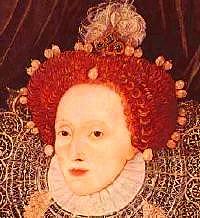 Her
place was taken by her half-sister Elizabeth. Elizabeth had
narrowly escaped death because of the fortunes of royal politics--and she
remained a very cautious queen for the 45 years of her rule of England
(1558-1603). Her
place was taken by her half-sister Elizabeth. Elizabeth had
narrowly escaped death because of the fortunes of royal politics--and she
remained a very cautious queen for the 45 years of her rule of England
(1558-1603). -
She was a Protestant
more by political fact than by personal conviction. In fact she managed
to keep her personal religious convictions to herself during her entire
rule. She ruled on behalf of England--not on behalf of either Protestantism
or Catholicism. Since most of her natural political allies
were Protestant, she was careful to give favor to the Protestant cause.
But her first thoughts were always to the independence and power of England.
-
Only gradually
did she undo the Catholic works of Mary and return England to the status
it had as a Protestant country under Edward VI.
-
Perhaps because
of her moderate policy, England during this time produced no more great
religious figures. Indeed, no particular religious revival seemed
to accompany the Protestant ascendancy during her reign. Because
of her religious moderation, religion itself remained moderate or unexceptional.
-
Politics, especially
the politics of playing off the Catholic French and Spanish kings against
each others so as to protect English independence, remained the more powerful
force in English life during her rule. Even with the Protestant Dutch,
politics and economics--rather than religion--remained at the heart of
English relations with this fellow Protestant country.
What was the Catholic church doing
during this period to protect its position in Europe?
-
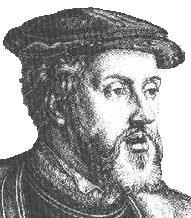 The
Catholic church's chief political instrument was the Habsburg Holy Roman
Emperor, Charles V (1519-1556)---who reigned also as Charles I of
Spain (1516-1556), then the most powerful country in Europe (thanks to
all the gold and silver it was bringing back from America). The
Catholic church's chief political instrument was the Habsburg Holy Roman
Emperor, Charles V (1519-1556)---who reigned also as Charles I of
Spain (1516-1556), then the most powerful country in Europe (thanks to
all the gold and silver it was bringing back from America). -
It was Charles that tried to supress
Luther's revolt in Germany. He viewed himself, as Holy Roman Emperor,
as the man most singly responsible for the defense of the true Catholic
faith against any heresy--especially the Lutheran heresy.
-
It was against Charles V's power that
the German barons and minor kings found cause with Luther's Protestantism.
At a time in which a handful of kings (Spanish, French and English) were
moving to consolidate their hold over ever-larger pieces of territory--at
the cost of the independence of local barons and lords--the German lords
were totally dedicated to making sure that Charles should have no such
success in Germany. This is why they were so eagerly "Protestant."
-
Charles would have gladly put an end
to this entire Protestant "heresy" except that his hands were tied by the
need to fight off the Muslim Ottoman Turks who threatened to overrun the
Habsburg lands in Eastern Europe. Even Vienna, Charles' Eastern capital
was under Turkish attack. Consequently Charles could give very little
time and attention to fighting Protestantism. In fact he needed the
military support of many of the Protestant princes and barons of Germany
to fight off the Turks.
-
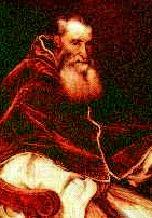 In
1534 Paul III was elected Roman Pope (1534-1549)--and began the
process of trying to bring reforms to the Catholic church, reforms that
still left the old ruling hierarchy (the episcopate) still in power, but
which cleaned up the morals and strengthened the talents of the Roman clergy. In
1534 Paul III was elected Roman Pope (1534-1549)--and began the
process of trying to bring reforms to the Catholic church, reforms that
still left the old ruling hierarchy (the episcopate) still in power, but
which cleaned up the morals and strengthened the talents of the Roman clergy. -
In 1542 he reorganized the Roman Inquisition--to
hunt out and remove heresy wherever it could be seized (actually possible
only in lands under pro-Catholic kings). This was the chief means
by which Protestantism was almost completely eliminated from Spain and
Italy before it could find a serious foothold there.
-
Finally, and reluctantly, Paul (under
pressure from Charles V) called a general church council at Trent
in 1545, to consider what changes might be necessary to recover the strength
of Roman Catholicism. It met (at different places subsequently) on
and off until 1563.
-
The Council of Trent responded
to the main principles of Protestantism by declaring that justification
is not by faith alone but by a combination of faith united with
loving works; it arises within a person through an internally acquired
righteousness (devotional works)--not through some external source
(such as God's pure grace). Furthermore, the interpretation of Scripture
should be left only to clergy trained in the church's long tradition of
Scriptural interpretation--and should never be undertaken by the
believer who has only his/her uninformed conscience as interpretative guide.
-
In fact, the Council of Trent conceded
nothing to Protestant theology, but only made the deeper commitment to
fight a more theologically organized counteroffensive against Protestant
heresy.
-
Also the Council agreed that bishops
should be all the more responsible to only the Roman Popes--in order to
tighten the discipline of the church hierarchy.
-
Most importantly, it put the Catholic
clergy on notice that a major religious war was on and that there would
be no moral or intellectual laxness permitted among Catholic clergy.
Everyone, from Pope all the way down to parish priest, was going to have
to shape up as a true soldier of the church.
-
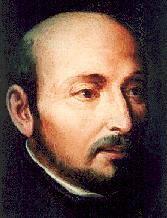 In
close accord with this idea was Ignatius Loyola, the most important
Catholic reformer of the period. In
close accord with this idea was Ignatius Loyola, the most important
Catholic reformer of the period. -
Ignatius was a Spanish noblemen serving
as a soldier, who decided in the early 1520s to give up his sword and armor--indeed,
all of the material trappings of life--to become a soldier for Christ and
the church instead--a soldier devoted personally to serving the Pope as
head of the church.
-
At first he was viewed with much suspicion
by the Spanish Inquisition--which was always suspicious about would-be
reformers who kept popping up within the church. For a while he was
even imprisoned. But eventually he was able to pursuade Catholic
officials of the sincerity of his desire to serve the Pope and Catholic
church.
-
Through his Spiritual Exercises,
Ignatius outlined the life of discipline, spiritual and physical, that
a soldier of Jesus should undergo in order to provide effective service
to his Lord.
-
He soon gathered around him a rapidly
growing band of individuals dedicated to living out exactly this vision
of service to God and Christ through service to the church and the Pope.
Thus Ignatius was outlining a powerful idea of service to God in
counter to the Protestant idea of faith in God as the centerpiece
of their respective religions.
-
Eventually, in 1539, this group was
formally organized as the Society of Jesus--known popularly at the "Jesuits."
In the generations and centuries ahead the Jesuits would come forth with
some of the most dedicated Christian missionaries in all of Christendom:
Jesuits faced cold, heat, starvation, torture and death to plant churches
in Asia and in the newly opening world of North and South America.
-
Finally there was always the Inquisition,
especially the Spanish Inquisition, authorized by popes to root
out heresy within Christendom.
-
It was the Inquisition that destroyed
the Cathars and their flourishing culture in Southern France in the 1200s.
-
It was the Inquisition that crushed
and exterminated Islam and Judaism in Spain in the 1400s.
-
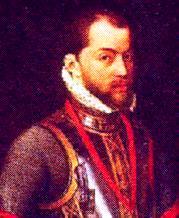 And
now with the rise of Protestantism in the early 1500s, it was the Inquisition
that was unleashed in Spain against this new heresy. And
now with the rise of Protestantism in the early 1500s, it was the Inquisition
that was unleashed in Spain against this new heresy. -
Particularly under Philip II (ruled
Spain from 1556-1598), the son of Charles V, the Spanish Inquisition was
ruthlessly used in Spain against rising voices of Spanish Protestantism.
The rack and stake proved to be quite effective at "protecting souls from
eternal damnation"--by terrorizing most of them back into the "saving faith"
of the Catholic church. Indeed, early into his reign Philip's Inquisition
eliminated almost completely any influences of Protestantism in that country.
What happened
to Protestantism (Lutheranism) in Germany?
-
In 1555 the situation
was so tight for Charles V in his struggle against the Turks that he met
at Augsburg and signed a treaty with the Protestant lords recognizing a
division between Catholicism and Protestantism that followed the wishes
of each of the local lords: would their particular state be Catholic
or Lutheran? That was to be the choice of the local lords.
-
This pretty much
divided Germany permanently into a number of independent Lutheran and Catholic
states.
-
However, the Peace
of Augsburg made no provision for the Calvinists--despite their great
strength in number in the Western towns along the Rhine River. Their
place in the German order would have to wait another 100 years before it
was recognized formally.
What happened
to Protestantism (Calvinist Huguenots) in France?
-
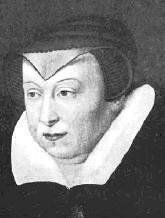 Eventually
Catherine de Medicis' toleration of Protestantism began to be undermined
by her jealousy of Coligny, the leader of the Huguenots, because of his
enormous influence over her son, the future king Charles IX (9th).
She thus conspired to have Coligny murdered--but succeeded only in having
him wounded. She thus met with the Guises and planned a more general
attack on the Huguenots: the St. Bartholmew's Day massacre
of August 24th, 1572. In one day, under her orders, thousands of
Huguenots (perhaps ten thousand), including Coligny, were murdered. Eventually
Catherine de Medicis' toleration of Protestantism began to be undermined
by her jealousy of Coligny, the leader of the Huguenots, because of his
enormous influence over her son, the future king Charles IX (9th).
She thus conspired to have Coligny murdered--but succeeded only in having
him wounded. She thus met with the Guises and planned a more general
attack on the Huguenots: the St. Bartholmew's Day massacre
of August 24th, 1572. In one day, under her orders, thousands of
Huguenots (perhaps ten thousand), including Coligny, were murdered. -
But the Huguenots
were far from wiped out by the slaughter--and now determined more than
ever to protect their faith from the treachery of French politics.
Wars between the Catholic authorities and the Huguenots were a regular
feature of life in France for the next 10 years.
-
In the meantime
the French Catholic party was splitting within itself--as the Catholic
strategy was increasingly drawing France into the net of Spanish power.
France stood in grave danger of becoming merely another province under
the rule of Philip II of Spain.
-
Some of the Catholics
began to enter into a political alliance with Protestant Henry of
Navarre, an heir to the French throne.
-
Meanwhile Catherine
was doing her best to keep her somewhat incapable son Henry III on the
French throne--especially as the Catholic party began to desert him and
look to Henry of Guise as a possible king in his place.
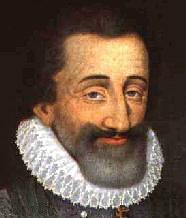 -
When Henry III
was assassinated at the end of 1588 and his mother Catherine died 13 days
later, Protestant Henry of Navarre was ready to take the throne.
To satisfy the fiercely Catholic citizens of Paris, Henry (now King Henry
IV of France: 1589-1610) renounced his Protestant faith and became
a Catholic. As he himself said, it was well worth a Catholic Mass
to gain France.
-
This move of Henry's
undermined the Guises' efforts to secure the French throne for themselves
and deprived the Spanish of a reason to be in France. Thus the Spanish
were forced to leave France. Soon France began to love its new king.
-
Even the Protestants
came to cheer him, because Henry was very generous and protective of his
former Protestant allies. In 1598 he decreed the Edict of Nantes,
confirmed the right of Protestants to worship freely, to hold public office,
and to protect themselves with their own fortified towns. Only certain
very Catholic cities (such as Paris) were closed to Protestant worship.
-
In that same year
the Spanish Habsburg King Philip II died--and peace in Europe was now finally
possible.
What happened
in the Netherlands?
-
As mentioned above,
Calvinism became increasingly popular among the prosperous merchants of
the coastal cities of Flanders and Holland in the northern, Dutch-speaking
part, of the "Low Countries" or Netherlands. But Calvinism
was also very popular among the French-speaking industrialists of the southern
or Walloon portion of the Netherlands.
-
The Emperor Charles
V was born a Dutchman in the Netherlands, and though a strict Catholic,
he remained somewhat tolerant of the Protestantism of his Dutch subjects
in the Netherlands.
-
But his son, Philip
II, as we have seen, was through and through a Spaniard and not so tolerant
toward Protestantism. When he took over the Habsburg empire from
his father beginning in 1555 he began to come down cruelly on these Protestant
"heretics."
-
But the Habsburg
lands were so vast that Philip apointed his half-sister Margaret, duchess
of Parma, as regent over the Netherlands. Though she took into her
own hands many of the political rights of the Dutch nobles, she seemed
to be fairly tolerant of their Protestant beliefs.
-
As a result Philip
himself began to intervene in the politics of the Netherlands, putting
the land under new Catholic episcopalian government and turning the Inquisition
loose on the Protestant population, to root out "heresy."
-
For a while Philip's
cruelty seemed only to increase the Protestant mood of the north--until
in 1566 a mob of Protestant rowdies began to loot and destroy hundreds
of churches in the region. This turned opinion against the Protestants--even
though the Protestant leaders too were horrified by the behavior of the
radicals. Once again the political advantage seemed to go to
Margaret of Parma.
-
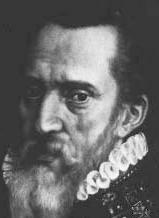 But
once again her brother Philip felt it necessary to press the hunt against
heretics in the north. He unleashed his ruthless general, Alvarez,
duke of Alva (or Alba), against the Protestant citizens of the Netherlands.
Over a six year period (1567-1573) over a thousand Protestant leaders were
executed and their leader, William of Orange, driven into exile. But
once again her brother Philip felt it necessary to press the hunt against
heretics in the north. He unleashed his ruthless general, Alvarez,
duke of Alva (or Alba), against the Protestant citizens of the Netherlands.
Over a six year period (1567-1573) over a thousand Protestant leaders were
executed and their leader, William of Orange, driven into exile. -
Alva's cruelty
and the fierceness of the Protestant reaction plunged the Netherlands into
horrible civil war (in Antwerp 7,000 people were killed in 11 days of fighting
in 1576). But bit by bit Alva's firm grip plus the excesses of some
Calvinist preachers and mobs pushed the South towards Catholicism while
the success of the Sea Beggars in their attacks on Spanish shipping and
troops in the North brought that part of the Netherlands under Protestant
control.
-
In 1578 Alessandro
Farnese of Parma, son of Margaret of Parma, took over as Regent of the
Netherlands. He was much more shrewd and diplomatic in his handling
of his responsibilities--though no less determined than Philip to bring
all of the Netherlands back under Spanish Catholic rule. Bit by bit
he was able to bring the southern 10 of the 17 Netherlands provinces back
under complete Spanish rule--the foundations of the modern state of Belgium.
-
He was stopped
short of completing the task of regaining the Northern provinces of the
Netherlands because Philip called him back to Spain to help in the upcoming
invasion of England (the ill-fated adventure of the Spanish Armada of 130
ships and 30,000 men in 1588--in which Philip lost half the ships and 2/3s
of his sailors). Thus the 7 northern provinces were able to elude
the Spanish grasp--and in time came to be recognized as semi-independent
as Protestant states--the foundations of the modern state of the Netherlands.
-
During this time
Dutch Protestants of the Northern Netherlands were turning more fully to
Calvinism and the Presbyterian system of church "polity" or organization.
Thus the Dutch Reformed Church became the leading religious institution
of the newly independent Netherlands.
-
But a spirit of
toleration descended on the Dutch Netherlands--perhaps because the people
began to feel fairly safe in the practice of their Protestant faith, perhaps
because they had seen too much killing for religious reasons. Indeed,
the Netherlands would soon be recognized as a safe haven for persecuted
people of all kinds of religious shades and attitudes.
-
Thus it was that
a group of Protestant English Pilgrims first came to the Netherlands to
find religious freedom--before they eventually sailed in 1620 on the Mayflower
to set up an English settlement at Plymouth on Cape Cod to practice their
faith in the New World..
|





 Miles
H. Hodges
Miles
H. Hodges